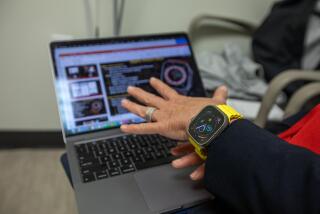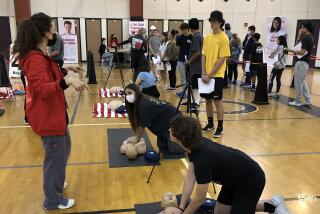Defibrillators less useful in hospitals than in public places, study finds
- Share via
Automated external defibrillators, which allow a layman to shock a person back to life after a heart attack, can nearly double the chances of survival for heart attacks suffered in airports, casinos and other places where there are bystanders able to help.
But in hospitals, it’s a different story, researchers said Monday. There, the devices — which have become widely used in recent years — not only provide little benefit but actually increase the risk of patients dying, a team of investigators reported at a Chicago meeting of the American Heart Assn. and online in the Journal of the American Medical Assn.
“The common sense was that AEDs in hospitals would save lives,” said Dr. Robert Ruelaz, an electrophysiologist at Hollywood Presbyterian Medical Center who was not involved in the research. “Common sense doesn’t always give us the answers, however. … This really opens our eyes to how difficult it is to save these patients.”
Between 2003 and 2008, more than 50,000 of the devices were sold to hospitals. The idea is that the first people to reach patients are often not equipped to provide sophisticated resuscitation but can handle the automated equipment.
Dr. Paul S. Chan of St. Luke’s Mid America Heart Institute in Kansas City, Mo., and his colleagues used data from the National Registry of Cardiopulmonary Resuscitation, which included 11,695 hospitalized patients who suffered cardiac arrests between Jan. 1, 2000, and Aug. 26, 2008. Of those, only 17.8% had arrests that were amenable to shocks.
Overall, about 18% of the patients survived to hospital discharge. Among those who were shocked, the rate of survival to discharge was 16.3% compared with 19.3% among those who were not shocked. When other factors were taken into account, use of the defibrillators was associated with a 15% lower chance of survival.
In an editorial accompanying the report, Dr. David E. Haines of the Oakland University William Beaumont School of Medicine in Royal Oak, Mich., noted that there was growing consensus that the best chance for revival of a victim involved sustained, uninterrupted compressions of the chest — one reason the American Heart Assn. guidelines for laymen no longer call for mouth-to-mouth resuscitation.
Using the automated defibrillators requires that the compressions be halted so that the computer in the device can monitor natural heartbeats. That interruption, Haines said, may interfere with the victim’s chances of survival.
“The compelling conclusions from the study … should lead to a consideration of a change in practice for in-hospital cardiac arrest,” he wrote. “Initiation of prompt and effective chest compressions should be the highest priority by first responders to the arrest.”





